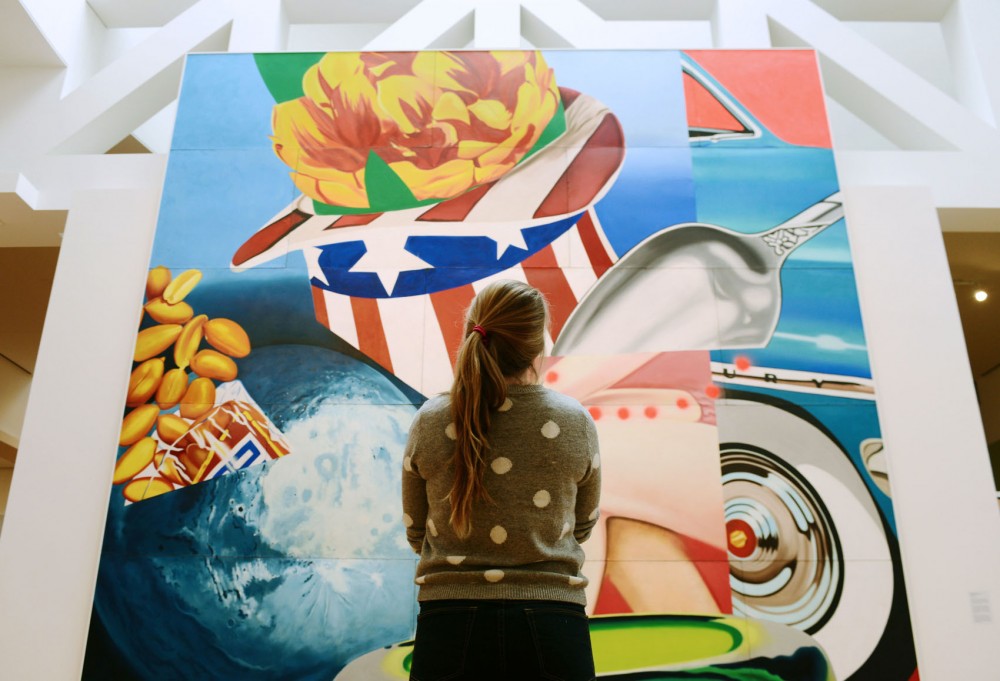On a quiet Monday evening in October 2007, police in Lynchburg, Va., surrounded the Maier Museum of Art at Randolph College.
The president of the college strode into the museum with art handlers, an attorney and members of his staff and told the museum director that a truck from Christie’s Auction House was on its way to pick up four paintings.
Phone and computer lines in the museum had been cut, so staff members inside couldn’t tell anyone what was going on. When people outside tried to find out what was happening, a police officer said there was a bomb scare.
By the next morning, the museum director had officially resigned from her position and the paintings — worth millions — were gone.
In recent years, money woes have led colleges nationwide to find new ways to stay in the black.
Randolph was one of the first in a line of cash-strapped schools that turned to their art collections for a bailout.
Selling or sharing art —perhaps one of the most unusual ways — has become increasingly common. Some in the higher education community argue that selling art is the only way to stay afloat. But to the art world, where selling pieces for financial gain is typically taboo, it’s a controversial trend — especially as recent cases give rise to fears that this will become the new norm.
Struggling schools
So far, it’s been mostly small liberal arts colleges that have turned to their art in times of trouble.
Financial difficulties hit harder for small, specialized schools that are struggling to stay relevant and attract students.
Randolph was historically a women’s college but became co-ed in the wake of decreasing enrollment and a 2006 financial warning from their accrediting agency. When it became co-ed in 2007, the school changed its name from Randolph-Macon Woman’s College.
“What you have are schools that themselves have become less viable in contemporary society,” said Laura Katzman, an associate professor of art and director of the college’s museum studies program who resigned before the 2007 incident.
Rockford College, a small liberal arts school in Illinois, sold most of its art collection in 2006 for $1.1 million. The same year, it sold part of its rare books collection, too.
On the opposite end of the spectrum, the University of Iowa drew attention in 2011 when the state Legislature introduced a bill proposing the Board of Regents sell its prized Jackson Pollock painting, a 1943 piece entitled “Mural.”
The painting’s value is estimated at $140 million. If the bill had passed, proceeds would have provided scholarships to Iowan undergraduates majoring in art.
This summer, Fisk University in Nashville, Tenn., got $30 million just for sharing part of its collection with a museum.
The historically black institution arranged to share half of its Alfred Stieglitz Collection of Modern American and European Art with Crystal Bridges Museum of American Art in Bentonville, Ark. The pieces will move between Nashville and Bentonville every two years.
The deal sparked a lot of controversy, including a 7-year legal battle over donor intent.
Given to the university in the late 1940s and early 1950s by Georgia O’Keeffe, the 101 pieces, from her private collection and that of her husband, photographer Alfred Stieglitz, include works by prominent artists like Picasso, Renoir and O’Keeffe herself.
But when the university encountered financial trouble and possible closure in the early 2000s, administrators started looking for money in new places.
The decision was made for multiple reasons, but it was primarily financial, said Sara Estes, gallery coordinator in the university’s Carl Van Vechten Gallery, where the Stieglitz collection is housed.
“They were in a dire financial strait,” she said, “and this was what they needed to do in order to get money for the university.”
The role of a collection
The more important an art collection is to a campus, the safer it is from being taken to the auction block.
But at many institutions, art is not seen as part of the school’s mission, said Mark Gold, a Massachusetts attorney with a background in museum studies.
“The trustees look at it and say, ‘OK, of the resources we have available to us … which are the closest aligned with our mission?’” he said. “‘Is that painting really closely aligned with the mission of providing education, or is the library? Or are the computers?’”
But some argue that campus art collections are part of their schools’ educational missions in the same way that libraries and other learning resources are.
“People often use the argument, ‘Well, you have [the art] in storage anyway, so why not sell it and make some money?’” said Lyndel King, director of the University of Minnesota’s Weisman Art Museum. “But I make the analogy of the library — you don’t necessarily sell the books just because nobody’s checked them out in five years.”
A vast majority of the Weisman’s collection is in basement storage.
The Weisman is accredited by the American Alliance of Museums, which requires museums to accept a “statement of permanence” — an agreement to keep the collection intact.
Because of this, the Weisman cannot sell art except for the purpose of buying other art. Its 21,500-object collection is made up mostly of gifts, King said.
Frank Sorauf, a former University faculty member and dean, lent pieces to the Weisman’s ceramics collection.
As the owner of “a very eclectic collection of art,” Sorauf said he has donated or shared pieces with a number of different museums.
If one of his donated pieces was sold, Sorauf said, he wouldn’t donate again in the future.
But, he added, “That’s the hard world of philanthropy.”
One piece in the Weisman collection, Arthur Dove’s “Gale,” is a favorite of second-year psychology graduate student Kristin Barstad.
She first saw the piece during her freshman orientation and likes that it’s still on display.
By exhibiting local artists’ work and serving as an educational resource for students throughout the state, she said, the museum holds value both for the University and the community at large.
“It’s not just a university museum on a campus,” she said. “It incorporates such a wide community that’s all around us.”
Because the University is a public land-grant institution, the Weisman has more of a public trust role than museums at private schools.
“It is part of our responsibility to preserve and extend our culture,” said Karen Hanson, senior vice president for academic affairs and provost, “and the artworks that people have given to us to hold in trust are part of the way in which we do that.”
And the building, designed by the architect Frank Gehry, has its own value and visibility as a destination.
“Build the museum, and they will come,” Katzman said. “That will protect the Weisman collection.”
The University administration has been consistently supportive of maintaining the collection, King said.
“For some people in the arts and humanities … museums and collections are akin to laboratories for some scientific researchers,” Hanson said.
“You’re in dire straits if you think that you want to part with some of the things that you may have lovingly collected in order to use, in part, for research and education.”
At other schools, though, the attitude has been different. When Randolph’s Board of Trustees decided to sell the four paintings, Katzman said, it didn’t think about the effect on the collection as a whole.
“It’s like cutting off someone’s arm and saying, ‘Well, you have another arm,’” she said.
All things considered
Despite the controversy, some say selling art is as good an option as any — and that, when done right, it can save a dying school.
When a college is in trouble, Gold said, every option should be considered — including selling art.
“I’m not saying ‘Go after the art,’” he said. “But I’m saying it’s not any more sacrosanct than faculty positions … everything has to be considered.”
But a lot of art donated to museums comes with the condition that it can never be sold, like with the Stieglitz collection.
But donors don’t necessarily think about what will happen if the receiving institution goes under.
“You give a gift with certain stipulations, and it’s hard for you to perceive how those stipulations will be perceived in a different era,” Katzman said.
When Rockford College sold part of its collection, it was deeply in debt.
There were also issues with maintaining the art — the college didn’t have enough storage space, and what it did have wasn’t climate-controlled.
Afterward, other schools contacted Rockford to ask how the sale was orchestrated, said John McNamara, the college’s senior development officer.
Rockford avoided controversy, he said, because the process was discussed with trustees, faculty members, alumni and students. The only pieces sold were those either not used for educational purposes, without significant historical value and didn’t have any donor restrictions.
“We really attempted to make sure that we were not disturbing the past or jeopardizing the future of the college by treating this cavalierly, just kind of back up a truck and put everything in it,” he said.
Window shopping
Today, one of the art world’s most controversial players is the 63-year-old daughter of Wal-Mart founder Sam Walton.
A variety of buyers have come forward to purchase art from colleges and universities, but the Crystal Bridges Museum has been one of the most talked about.
The museum, founded by heiress Alice Walton, opened in 2011. It has raised eyebrows in the art world, in part because of its patron’s uncommon ability to outbid others.
“No other museum can match their wealth at this moment,” King said.
The Walton Family Foundation gave $1.2 billion to establish the museum’s endowment, and admission to the museum is free, thanks to $20 million from the Wal-Mart Foundation.
In 2007, Walton, along with the National Gallery of Art in Washington, D.C., offered $68 million to Thomas Jefferson University in Philadelphia for Thomas Eakins’ “The Gross Clinic.” The offer, made through Christie’s, caused an uproar in the Philadelphia art community. Ultimately, local museums matched the offer and kept the painting in the city, where it’s now shared between the Philadelphia Museum of Art and the Pennsylvania Academy of the Fine Arts.
The Crystal Bridges Museum was able to purchase Eakins’ “Portrait of Professor Benjamin H. Rand” from the university for an undisclosed amount the same year.
Museum spokeswoman Diane Carroll said Crystal Bridges had not considered purchasing pieces from any other colleges or museums, including Randolph.
But according to Katzman, Walton visited Randolph in 2007 when the school was in the midst of trying to sell pieces in its collection. Though Walton did not make an offer on any of the pieces in the collection, Katzman said she was invited to campus and was shown around.
“Probably to the disappointment of those who invited her,” Katzman said, “she was clearly not there to make any deals right then and there.”
Changing value
For a long time, many schools didn’t even know what their art was worth.
In the 1970s, the market value of American art began to increase drastically, Katzman said. Many schools had accumulated eclectic collections over time, she said, and hadn’t assessed the value of what they had.
Randolph had a large collection of American art that was initiated in 1907 by the college’s first art professor.
“The [Randolph] board was probably starting to look at the collection and think, ‘Oh, maybe our Edward Hopper shouldn’t be right outside the dining hall,’” Katzman said.
Unlike sales of other educational assets, like library books or scientific resources, there’s a lot of publicity with art sales and the money that comes with it, King said.
Not all art is valuable though, she said, and there are additional costs that come with making a sale.
And as art is monetized, Katzman said, there’s less interest in holding on to it.
“It’s not just economics, it’s also priorities,” she said. “The priorities are not art museums, typically, because they’re not moneymakers.”
As more schools flock to auction houses and wealthy museum patrons, some worry the trend will only continue to spread.
Decisions about campus collections could impact the museum community as a whole.
“It hurts all of us when a few museums do this,” King said, “because donors think, ‘Well, if this museum did it, why not the museum I’m thinking about?’”
The result of the Fisk litigation, for example, could discourage potential donors not just there, but elsewhere.
Estes said the decision at Fisk could encourage other schools to think about selling art in the future.
“Now that this has happened once, it could very much be a solution that is brought up in other cases like this,” she said.
At Randolph, the effect has already been felt.
Katzman said donors have called her to say they were considering donating art to the Maier Museum, but were worried about what might happen to it.
The 2007 incident has made the collection vulnerable, she said.
“It will be tapped into,” she said. “Once you set a precedent, it’s a lot easier to continue to do it.”

















